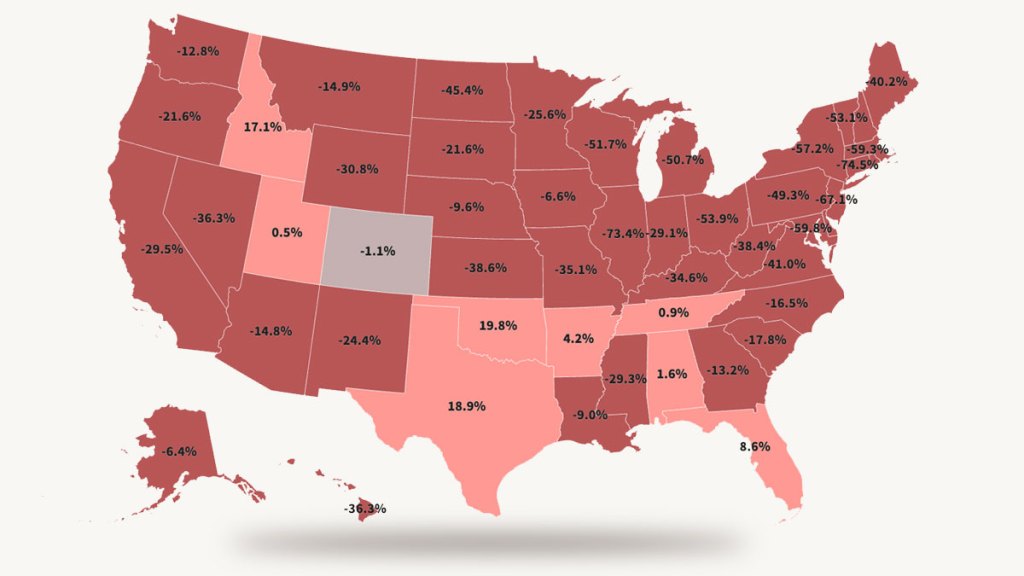Unsold inventory of homes on the market has been climbing in the U.S. for two years, right along with rising mortgage rates. In general, inventory rises with rates because more expensive money slows demand. When demand slows, inventory grows.
According to Altos Research, there are 40% more homes on the market at the end of August 2024 than there were last year at this time. That means currently just over 700,000 single-family homes are unsold, with about 10% of those going into contract each week, and another 75,000 new listings. But still, there are about 300,000 fewer homes on the market now than in August of 2019. Inventory is climbing but it’s still pretty restricted.
And importantly, inventory isn’t growing everywhere equally. Florida and Arizona have 70% more homes unsold on the market now than last year, while New York has only 10% more.
While every state in the country has more homes unsold on the market than last year, 2023 wasn’t “normal.” We were still emerging from the crazy pandemic market. So rather than comparing to last year, the closest we get to a “normal” market is to use 2019 as a baseline. And eight states have more unsold inventory than in 2019.
That is, eight states are back to “normal.”
Meanwhile, some states, especially in the Midwest and Northeast, still have barely more available inventory than during the pandemic. Illinois and Connecticut have almost 75% fewer homes for sale now than in 2019.
In the map below, the lighter states have more homes unsold. Inventory is building in these states compared to 2019 — these are much more normal conditions than the rest of the country. These states are Oklahoma, Texas, Idaho, Florida, Arkansas, Alabama, Tennessee and Utah, with Colorado getting close to positive inventory levels.
Why does it matter?
One reason to pay attention to these inventory trends is that the faster we get back to “normal” markets, the better the environment will be for homebuyers. Buyers have more selection, with less upward price pressure, in an affordability-challenged market.
Another interpretation of these inventory trends is more bearish. That is, areas with greater supply of unsold homes are more likely to have downward price adjustments. For housing market watchers who are expecting home prices to decline, they’re looking for areas where supply and demand grow significantly imbalanced. These eight states are the leading candidates.
Why these states?
Why do these states have such inventory growth, when much of the Midwest and Northeast have barely budged off the pandemic lows of inventory? The answer seems to lie in migration patterns.
During the pandemic, most of these states were inbound migration states. People moved from the Northeast to Florida. Or moved from California to Texas and Idaho. (Migration is within the U.S., from state to state. Don’t confuse this trend with immigration from outside the country). These migration patterns were already underway and they were turbocharged during the pandemic. Homebuilders leaned into the trends and have been building a lot of homes in these parts of the country.
Since mortgage rates started rising in 2022, Americans have shifted into what we might call The Great Stay. We’re moving less. Migration is way down. We’re quitting our jobs less. Companies are hiring less. We’re buying and selling fewer homes.
Since 2022, Americans are staying put.
So If Chicago has a long history of outbound migration, those homes would normally be listed for sale. Those Chicagoans would normally be buying a home in Dallas. The “normal” Chicago housing market assumes a certain outbound flow. The Dallas housing market assumes a normal inbound flow. When that flow stops, there are fewer homes sold in Chicago, and more unbought in Dallas.
According to John Burns Real Estate Consulting – Austin, Texas, in 2024 actually has net outbound migration — perhaps for the first time in 15 years. More Americans are moving out of Austin than in — at least for this stretch in 2024.
Idaho and Utah famously had dramatic migration from California during the pandemic. That firehose has slowed to a trickle.
Consider homebuilding rates. These destination states have almost all had the highest rates of new construction in the country. If builders are expecting the migration wave to continue, and it doesn’t, then inventory builds. Likewise, construction in a place like Ohio can be at a very slow pace, since the state has outbound migration. But when that migration stops, then the construction pace isn’t fast enough.
Why outbound migration?
It’s not just slowing inbound migration that impacts the inventory in these states. The costs of homeownership are climbing too. Texas, in particular, is a high tax state for real estate. If you bought a home in 2019 in Austin, your taxes are dramatically higher now. Colorado — which still has fractionally fewer homes on the market than 2019, but is next in line to cross over — has property tax relief on the ballot this fall because homeowners are paying so much more in taxes after the sharp rise in home prices of the last four years.
Florida homeowners have the tax costs and also have sharply rising insurance costs — especially after Hurricane Ian. If you own a second home in coastal Florida, even with a 3% mortgage, your insurance costs may have tripled in recent years. When the costs to hold real estate rise, we hold less real estate. We sell more, that adds to inventory.
What happens next?
The Great Stay seems to be the product of higher mortgage rates and a cautious outlook on the economy. Businesses are afraid to hire too much and employees are afraid to quit the good gig they have. Homeowners have their well-documented mortgage rate lock-in effect after a decade of ultra-low mortgage rates. The macro economic trends that finally motivate the labor market are probably the same trends that motivate migration and home buying in the destination states.
Are these eight states the harbinger of inventory gains — or of imbalances that lead to a home-price correction? Or, as the business cycle turns, do these extreme conditions gradually ease?
If we’re lucky and we’ve passed the peak of interest rates, then the Great Stay trends may also be at their peak now. That implies that in 2025, inventory tightens in the destination states and probably eases a bit in the outbound states.






